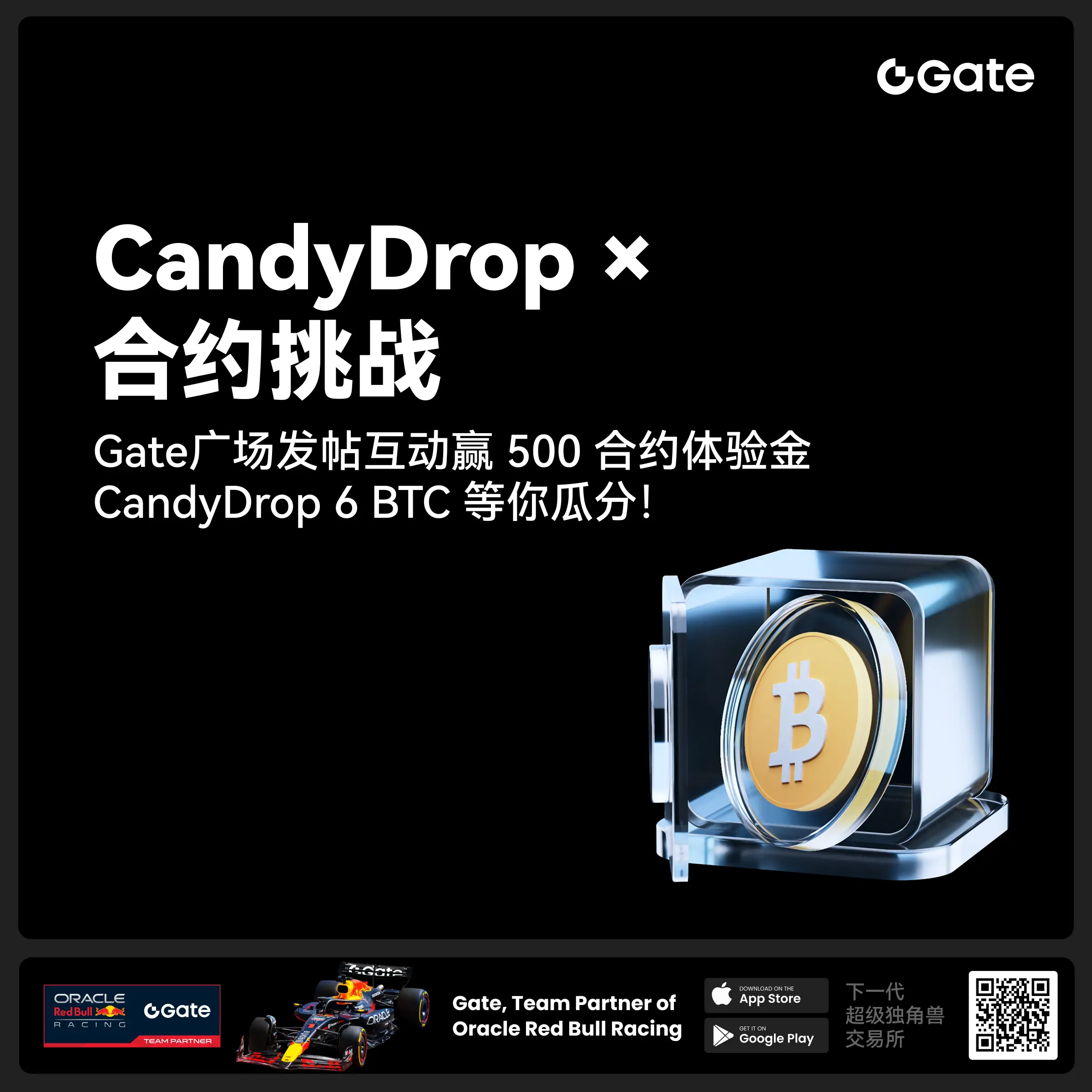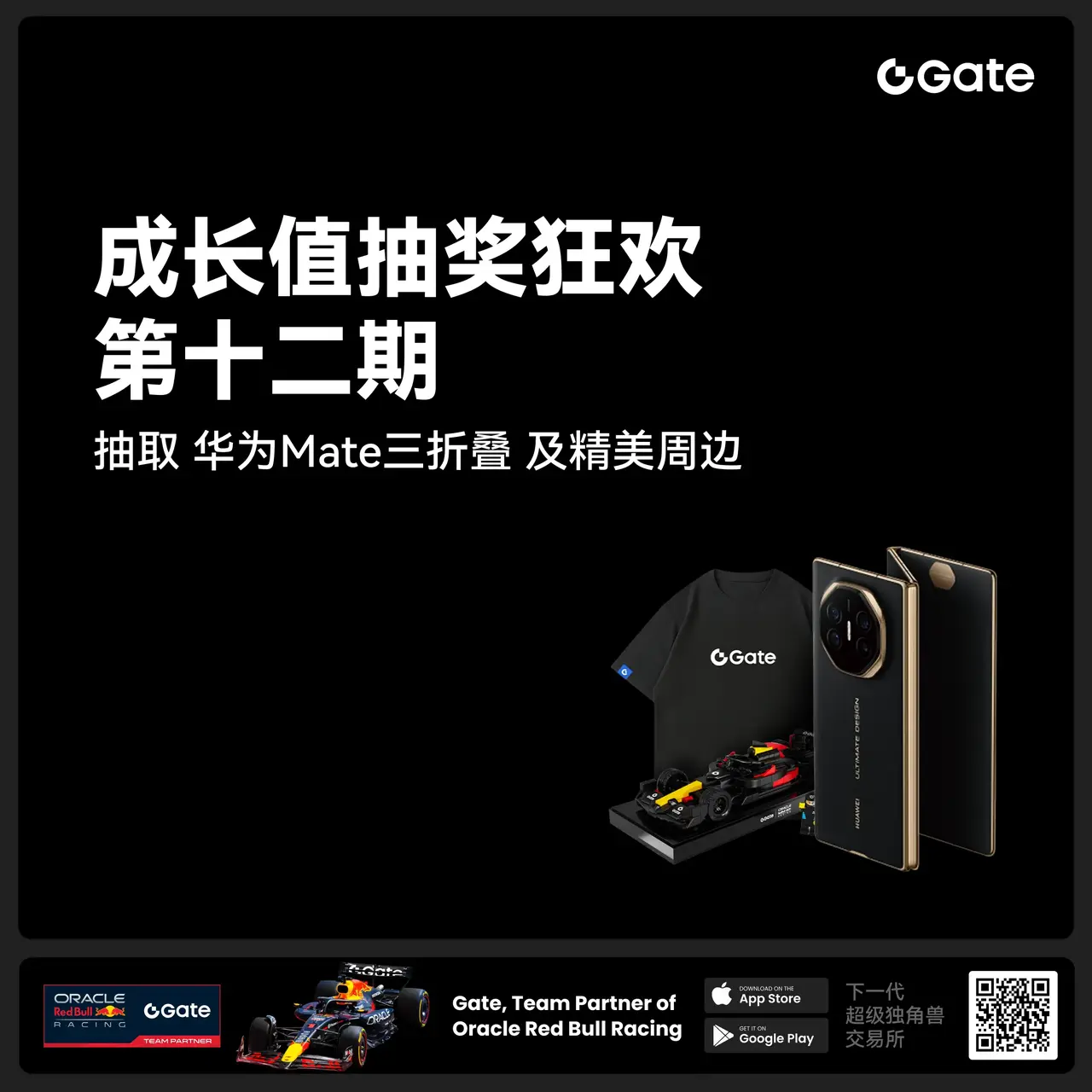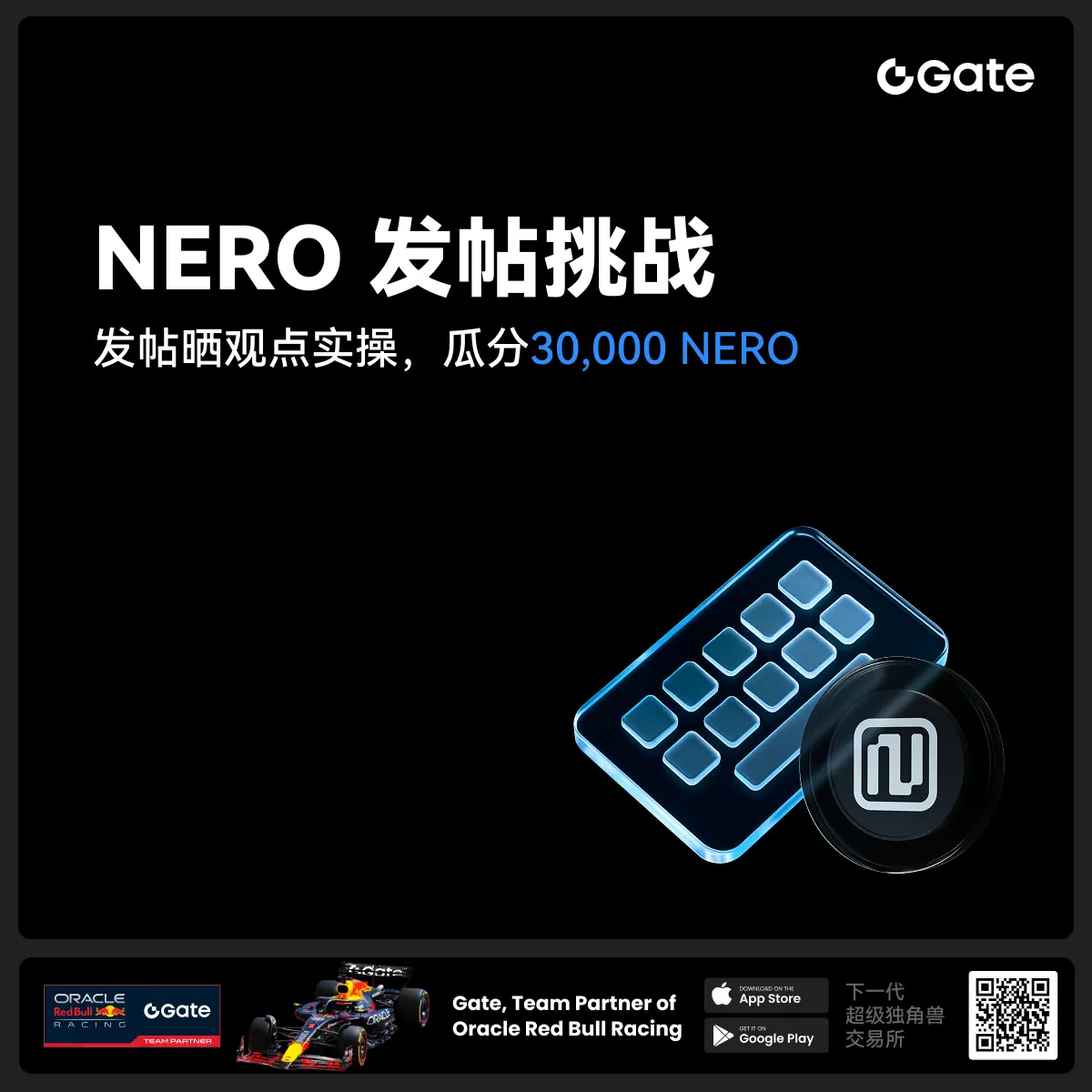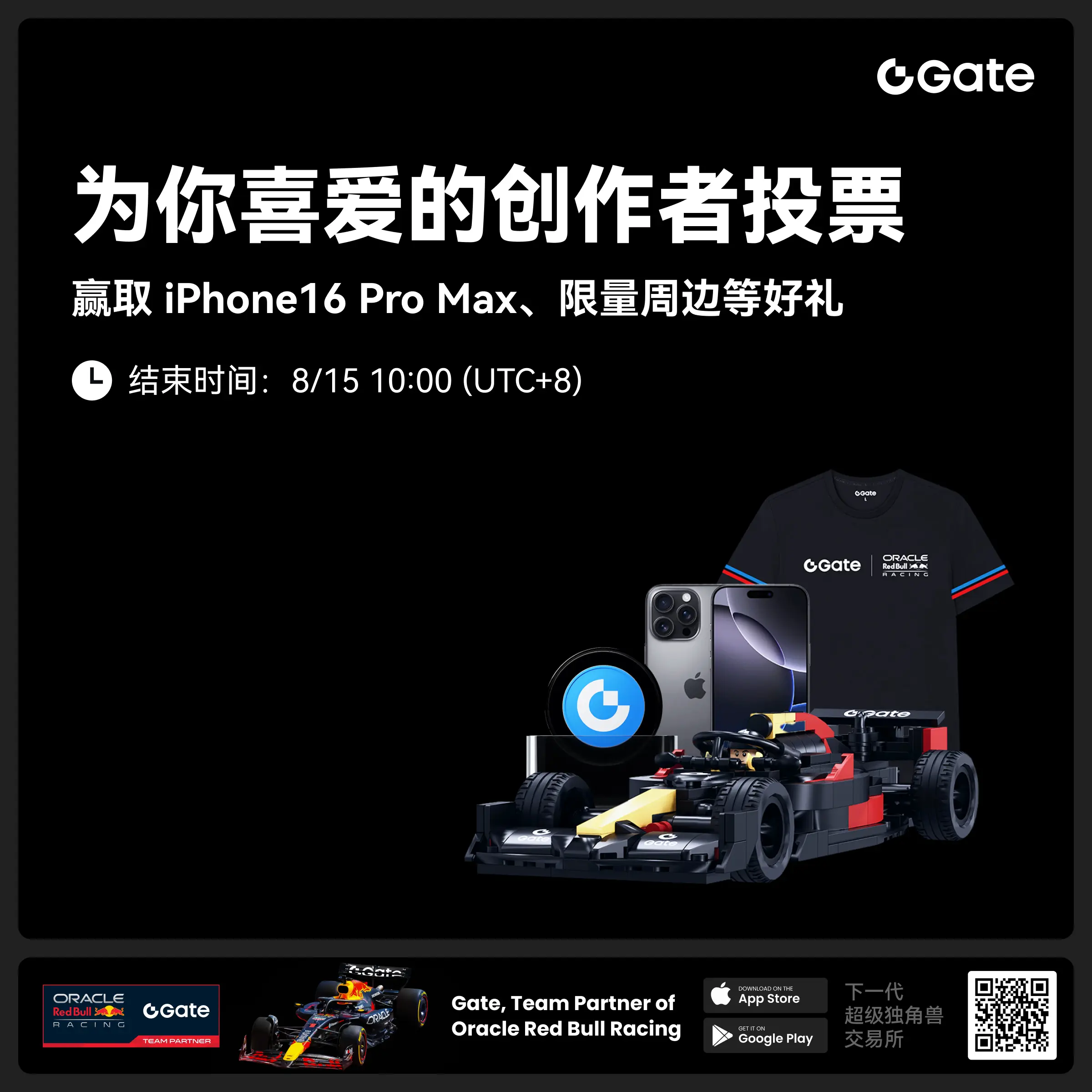- 话题1/3
55k 热度
38k 热度
53k 热度
9k 热度
21k 热度
- 置顶
- 🎉 #CandyDrop合约挑战# 正式开启!参与即可瓜分 6 BTC 豪华奖池!
📢 在 Gate 广场带话题发布你的合约体验
🎁 优质贴文用户瓜分$500 合约体验金券,20位名额等你上榜!
📅 活动时间:2025 年 8 月 1 日 15:00 - 8 月 15 日 19:00 (UTC+8)
👉 活动链接:https://www.gate.com/candy-drop/detail/BTC-98
敢合约,敢盈利
- 🎉 攒成长值,抽华为Mate三折叠!广场第 1️⃣ 2️⃣ 期夏季成长值抽奖大狂欢开启!
总奖池超 $10,000+,华为Mate三折叠手机、F1红牛赛车模型、Gate限量周边、热门代币等你来抽!
立即抽奖 👉 https://www.gate.com/activities/pointprize?now_period=12
如何快速赚成长值?
1️⃣ 进入【广场】,点击头像旁标识进入【社区中心】
2️⃣ 完成发帖、评论、点赞、发言等日常任务,成长值拿不停
100%有奖,抽到赚到,大奖等你抱走,赶紧试试手气!
截止于 8月9日 24:00 (UTC+8)
详情: https://www.gate.com/announcements/article/46384
#成长值抽奖12期开启#
- 📢 Gate广场 #NERO发帖挑战# 秀观点赢大奖活动火热开启!
Gate NERO生态周来袭!发帖秀出NERO项目洞察和活动实用攻略,瓜分30,000NERO!
💰️ 15位优质发帖用户 * 2,000枚NERO每人
如何参与:
1️⃣ 调研NERO项目
对NERO的基本面、社区治理、发展目标、代币经济模型等方面进行研究,分享你对项目的深度研究。
2️⃣ 参与并分享真实体验
参与NERO生态周相关活动,并晒出你的参与截图、收益图或实用教程。可以是收益展示、简明易懂的新手攻略、小窍门,也可以是行情点位分析,内容详实优先。
3️⃣ 鼓励带新互动
如果你的帖子吸引到他人参与活动,或者有好友评论“已参与/已交易”,将大幅提升你的获奖概率!
NERO热门活动(帖文需附以下活动链接):
NERO Chain (NERO) 生态周:Gate 已上线 NERO 现货交易,为回馈平台用户,HODLer Airdrop、Launchpool、CandyDrop、余币宝已上线 NERO,邀您体验。参与攻略见公告:https://www.gate.com/announcements/article/46284
高质量帖子Tips:
教程越详细、图片越直观、互动量越高,获奖几率越大!
市场见解独到、真实参与经历、有带新互动者,评选将优先考虑。
帖子需原创,字数不少于250字,且需获得至少3条有效互动
- 🎉 亲爱的广场小伙伴们,福利不停,精彩不断!目前广场上这些热门发帖赢奖活动火热进行中,发帖越多,奖励越多,快来GET你的专属好礼吧!🚀
1️⃣ #GateLaunchpad上线IKA# |IKA认购体验
在Gate广场带话题晒出你的IKA Launchpad认购体验,4位幸运分享者讲瓜分$200分享奖池!
详情 👉️ https://www.gate.com/post/status/12566958
2️⃣ #ETH冲击4800# |行情分析预测
大胆发帖预测ETH走势,展示你的市场洞察力!10位幸运用户将平分0.1 ETH 奖励!
详情 👉️ https://www.gate.com/post/status/12322403
3️⃣ #创作者活动第二期# |ZKWASM话题
在广场或推特发布与 ZKWASM 或其交易活动相关的原创内容,瓜分4,000枚ZKWASM!
详情 👉️ https://www.gate.com/post/status/12525794
4️⃣ #Gate广场征文活动第二期# |ERA话题
谈谈你对ERA的观点/体验,参与并推广活动,700 ERA大奖等你赢!
详情 👉️ https://www.gate.com/post/status/12361653
5️⃣ #MBG任务挑战# |MBG话题
分享你对MBG的洞察,积极参与和推广MBG活动,20位小 - 🎉Gate 2025 上半年社区盛典:内容达人评选投票火热进行中 🎉
🏆 谁将成为前十位 #Gate广场# 内容达人?
投票现已开启,选出你的心头好
🎁赢取 iPhone 16 Pro Max、限量周边等好礼!
📅投票截止:8 月 15 日 10:00(UTC+8)
立即投票: https://www.gate.com/activities/community-vote
活动详情: https://www.gate.com/announcements/article/45974
Back to Basic:通过链下 NFT 实现零成本无需许可的福利
撰文:Starzq和Ruby Wang
最近的市场,让不少 builder 和 VC 发问「Web3 除了投机,还能做什么?」
Back to Basics, Web3 的核心一直都是关于 ownership, 围绕个人所有权与数据建立下一代互联网,这里面一大关键特点就是 Permissionless(无需许可)。
在金融领域,智能合约实现了 Permissionless Issuance ,Uniswap 开创了 Permissionless Trading; 在更大用户规模的消费领域,不少项目和品牌都在探索 Permissionless Perks, 建立用户端集成的无需许可的福利,包括我们熟知的 Web3 Native IP BAYC 和 Azuki, 以及 Web2 消费品牌星巴克、Adidas 和 Nike。
在已经开启的夏日会议活动季,如果你去参加线下的 web3 聚会,无论是 NFT 的社区活动,还是开发者会议,已经可以开始解锁这样灵活而高效的用户端集成体验。同时也能感受到 Token 除了作为交易标的,在实际生活及消费应用场景中的另一种可能。
一、背景
当上一波强金融属性用户进入时,创建去中心化钱包和上链尚可接受,毕竟 Web2 世界开户和 KYC 更加繁琐。
Web3 要达成 Mass Adoption, 消费用户绝对是主力。但对于消费属性的用户,在 Web2 世界的使用成本接近为 0,来到 Web3 需要有钱包来存储用户身份和资产,真的需要如此「昂贵」的用户交互和上链吗?
我们将其拆为为 3 个问题👇
在这个问题上,成立了 7 年的 Smart Token Labs (下文简称 STL)一直在探索,也给出了自己的答案:
Smart Token Labs 基于这 3 个回答,打造了 1 套融合链下和链上的 Smart Layer, 使得用户无需开钱包,不必消耗 gas, 通过 URL 验证链下 NFT 即可获取基于特定身份的权益,也为品牌打开了更大的 Open Loyalty 空间。
比如这周,5.19-5.23 于黑山举办的以太坊 EDCON 2023,参会观众就可以体验到,组织团队与 STL 合作提供无需许可的福利。通过独立验证票务所有权,观众可在会议官网平台及线下领取第三方提供的各项特权。
二、Open Loyalty 与 用户端集成
什么是用户端集成
「集成」这个概念,相信对于了解品牌会员或互联网平台用户端服务的人来说并不陌生。比如在一个电子商务网站中,引入第三方支付服务,让用户可以直接在网站上完成支付,称为「第三方集成」。
在 Web2 或传统商业世界中,这种集成主要通过第三方 API 实现,而用户的数据和权限被储存在中心化的服务器中。这里的最大障碍是,受限于开发和商务能力,能开发和接入 API 的品牌屈指可数,用户的选择也很有限,还有数据隐私问题。
web3 用户端集成的方式,是把原本封闭在中心化数据库内的用户信息,处理成用户能控制使用真正拥有的密码学 token, 然后以 token 作为集成点来接入各种第三方服务。
还是以 EDCON 举例:用户购买了门票,这个信息原本是封闭在 EDCON 的门票系统数据库内;现在 STL 把这个信息处理成证明 token(Attestation token),给到用户手里。原本需要 EDCON 票务系统与许多第三方对接集成才能实现的功能,现在都可以轻易的实现了。用户可以向所有会务周边服务提供商证明他是 EDCON 购票用户获得相应权益,并且只根据自己的需求选择合适的服务提供方,而无需担心邮箱等联系人数据泄漏的打扰。
用户端集成真正做到了让用户成为中心,构建围绕自身所有权及身份相关的特权平台。
开放会员系统(Open Loyalty )如何实现
Token 化使得资产(权益)的证明,都可以由用户自己完整,不需要原本的发行方参与, A 品牌可以无需 B 品牌参与就能验证用户在 B 品牌的资产(权益),省去了与 B 品牌谈判合作、系统对接数据交换等步骤。@Starzq 之前也提到过,当会员数据上链后,会出现一次商业范式转移,品牌获取用户的方法从 pull 变成 push,价值回归用户,同时品牌需要学习新的与用户对话方式。
针对 Open Loyalty,可以参阅 web3brand 的另一篇文章提到的三个有趣案例:NFT 市场的下一个新叙事:Open Loyalty
这样的范式转移也尤其适用于活动&票务场景:
由于参与 EDCON 的用户既是核心的区块链建设者又会在黑山住宿和消费,那么会务上的参展方,VC 以及黑山市内的餐饮场所等都可以基于持票参会这一用户身份给用户相应的福利权益来精准吸引用户。
「参会者将获得至少 25 个福利,从获得 EDCON 周边的衍生品 Cool Cat 的免费铸造能力到从著名的当地黑山餐厅之一获取 50 个‘Njegusi Prosciutto’的机会。」 EDCON 联合主办方,以太坊大学的市场负责人 Sky Harris 认为「无需许可的福利」是为参会者创造附加价值的好方法。
用户端集成 + 开放会员系统 = 无需许可的福利
因此,基于这个 STL 部署的针对参会者福利平台 Permissionless Perks,用户可以自由使用自己的可验证信息,不经过「中间商」直接和福利提供方联系,提升参会体验;而品牌及服务提供方吸引精准的用户(经过验证的参会者)并为其创造价值,同时也大大减轻了活动组织者的沟通与对接合作负担,提升沟通效率。
参考上一次波哥大 Devcon 的经验,Permission Perks 使得参与互动率为 58%,两倍于行业平均水平。
三、无需许可的福利平台的体验路径
我尝试看了下各方的体验,都相当简洁清晰。
如果你是参会者
参会者将通过 EDCON 电子邮件以 URL 格式接收其票务证明,该 URL 将参会者引导至无需许可的福利页面,无需登陆或连接钱包,或直接访问官网 ,在该页面上浏览并领取从 VC 优先联络到项目方 Merch 等各项权益。有点类似展会拿参会证去各个线下摊位打卡,现在完成了线上无缝对接的体验。
同时可以参考这个推特🧵了解更多: Token by Smart Token Labs on Twitter
一些可以兑换的 perks 举例:从 NFT,merch 到 VC 联络
如果你是活动举办方
协作变得非常简单,因为任何第三方都能通过连接「无需许可的福利」平台本身,为活动参与者提供福利来为会议增值;主办方不需要与多端数据对接,围绕每个活动都能快速创建一个基于会员独特身份的服务型市场。同时,票务所有权的证明 Token 存储在本地浏览器,以实现与 EDCON 福利提供者网站的无缝集成。验证发生在票务持有人和福利提供者之间,不涉及活动组织者,且福利可以是长期有效的。
「无需许可的福利」平台计划在 23-24 年通过与以太坊会议的合作,连接大约 1.2 万参会人员。
四、对未来活动组织与品牌权益发放的畅想
虽然仍在早期,但我相信通过用户端集成与开放会员系统(Open Loyalty)所带来的体验与效率提升,会逐步渗透到活动组织与日常消费。总结下我对趋势的三点思考:
再小的品牌与个体也可以构建基于自身的生态圈
原本需要一定的技术资源储备,大公司才能对接多方来实现的会员福利平台,现在的解决方案足以让个人创作者或者独立品牌运营核心用户成为可能。随着工具的成熟,需要 onboard 的更多是业务运营主体(品牌,创作者,活动主办方),毕竟将来的关系更多是基于运营主体与用户的直接联系,才能提升整体的消费者体验。
我在之前 A7X 乐队的票务案例中也提到,创作者掌控给粉丝的体验以及社区运营是成功的关键
这周,知名板球运动员 Glenn Maxwell 也通过 STL 的合作向自己的粉丝发放不需要注册 Crypto 钱包就可以领取的会员 token,更好地运营自己的粉丝社区。
积极参与的用户将收获实际的价值
随着数据的积累,未来品牌获客的方式也会从向中介平台投放广告逐步转向直接奖励参与,更为精准地找到 real user。用户端集成使得用户通过自己做拥有的资产、数据与行动去定义与证明自己的身份价值,并通过无缝的场景对接获得更多的特权。
Token 化创造开放的服务&权益市场
STL CEO Victor Zhang 认为,Token 化可以高效的创造两个市场,一个是 token ownership 的交易市场,让交易流转更加高效; 另一个是开放的集成服务市场,让产品和服务方在自由市场下竞争(不再受限于大型集成平台或者其他用户数据原始产生方,他们需要提供服务所依据的可验证数据以 token 的形式在用户自己的手里)有机会通过创新,向用户提供更好的产品和服务。
期待通过开放的服务权益市场,web3 将真正地走入消费与线下场景,创造更为持续的用户价值。